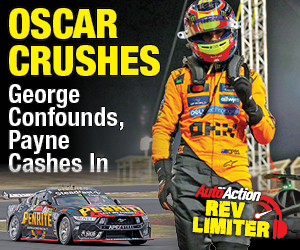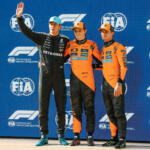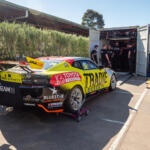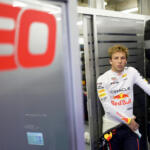Piastri dominates in milestone Bahrain triumph
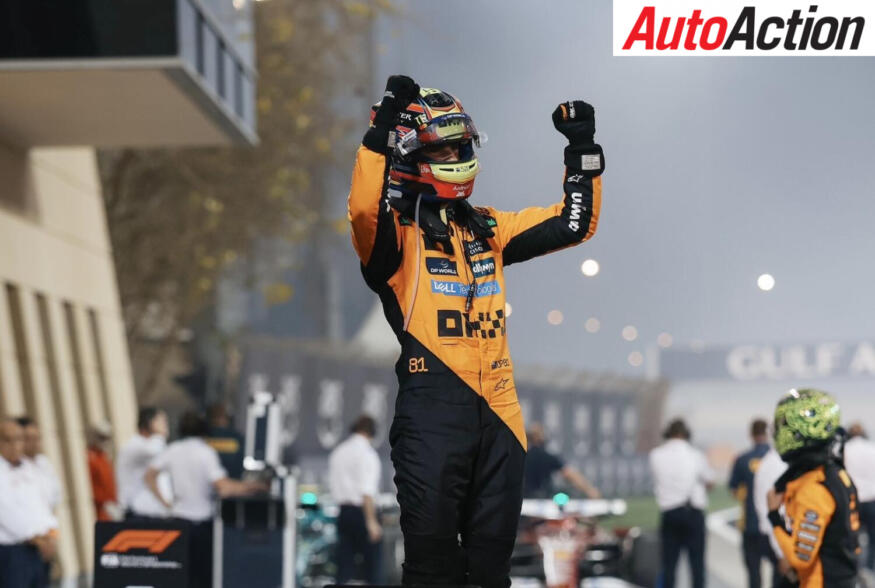
By Reese Mautone
Date posted: 14 April 2025
Oscar Piastri delivered a desert masterclass in Bahrain, crushing the field to claim a milestone victory in his 50th Grand Prix, securing McLaren’s first-ever win at their ‘second home’ and completing a rare hat-trick to move within two points of the championship lead.
Approaching sunset in Sakhir, all 20 drivers locked in on the five lights—thundering into action as the Bahrain Grand Prix roared to life.
It seemed to be a dream start for both McLaren drivers, with Piastri charging clear of the battles behind while his teammate, starting from sixth on the grid, made up three places through the first sequence of corners.
Spoiling the Bahraini-backed team’s party, Lando Norris soon received a penalty for being out of position on the starting grid, serving it during his first pitstop of the evening.
As for their neighbouring competitors, the run down to Turn 1 saw George Russell reinstating himself into the top two after he lost his front-row grid box due to a post-qualifying penalty, demoting Charles Leclerc as he swept through the first lap.
Not as fortunate off the line was Max Verstappen, with his poor launch foreshadowing an equally disappointing evening in Bahrain, allowing the slower Williams to get the jump on him.
As the scrambled race began to unfold, Norris was instantly given the hurry-up and told to make quick work of the Mercedes ahead to protect himself from the added five seconds of race time, however, he was unable to close the margin by the time the McLaren pit wall elected to make its first stop on Lap 10.
As a result, the Brit rejoined in P14—a more favourable position compared to the Red Bull duo who both fell victim to an internal exit light malfunction which saw Verstappen and Tsunoda both held up in their pit box for over six seconds.
Russell followed suit, pulling into the pitlane a few laps earlier than the race leader, while Ferrari—the only top-ten team to start on the medium compound—opted to extend their first stint, with Leclerc practically begging his engineers to consider a one-stop strategy under the codeword “delta”.
With his pleas denied, Ferrari completed a smooth double-stack, reinstating Piastri into the race lead.
Leclerc clawed his way back to the rear of Norris, and with his tyres being seven laps younger, he soon found himself touring the Bahrain International Circuit with DRS assistance.
Like poetry, the #16 and #44 completed synchronised overtakes on Norris and Kimi Antonelli, respectively, separated by just four corners as the teammates edged closer to their largest points haul of the season.
The second round of pitstops kicked off as the race approached half-distance, with Verstappen the first bow into the pits, however, regrettably so when he suffered yet another slow stop, this time due to a delayed transition on his right wheel.
Antonelli was the only driver to react, moving to the soft compound tyre before the entire race was neutralised, with the Safety Car gracing the circuit for a short period of time while debris from an incident between Tsunoda and Sainz had to be cleared from the racing line at Turns 1 and 2.
Their altercation wasn’t the only one that involved the Williams race car racking up damage in Bahrain, with Sainz’s aggressive approach seeing a huge hole later being ripped in his sidepod, forcing Sainz to retire.
The Safety Car played perfectly into Piastri’s hands, allowing the race leader to hold onto P1 when he rejoined the 57-lap race, with Russell, Leclerc, Norris and Hamilton rounding out the top five.
At the restart, Russell admitted that he thought about making a move on the Australian, however, as Piastri launched from Turn 14, the DRS advantage was short-lived for the Mercedes driver.
Instead, it was the #81’s teammate who found himself engaged in a three-way battle for the final podium position, sandwiched between the Ferrari duo.

Norris had his sights firmly on moving ahead of Leclerc, however, he was forced to shift his focus when Hamilton got the jump, with Norris defending and regaining his position beyond track limits at Turn 4.
The moment prompted the McLaren pit wall to inform its driver to hand the position back to the Ferrari, but it was only temporary when the #4 legally completed the overtake for P4 on the following lap.
With 15 laps standing between the field and the chequered flag, Norris was within striking distance of Leclerc, growing impatient as he launched down the outside of the opening turn, locking up and losing vital time.
Three laps later, he forged up the confidence to try again, this time into Turn 4, however, it reaped a similar result to his earlier defensive efforts when he found himself over the white line.
Persistence paid off and P3 was finally Norris’ after he learnt from his mistake, clearing Leclerc at the same corner as the Ferrari driver battled a strong snap on the kerbs.
In the final few laps, the top five had settled into its finishing order, however, it was a close call for Russell who suffered a brake-by-wire failure in the closing stages—an issue that also impacted his dash and DRS function, with the latter causing the Brit to be under post-race investigation for a DRS infringement.
As a result, both Norris and Leclerc made it their final mission to be within five seconds of the #63 as they took the chequered flag in Bahrain.
Not having to worry about intervals, or anteing for that matter, was Oscar Piastri who crossed the finish line 15.5 seconds clear of any threat, becoming the first repeat race winner of the season in his milestone 50th race.
Winning McLaren’s ‘second’ home race—something the papaya outfit has never managed to do—in a commanding style, the Australian also became the 49th driver to score a hat-trick of Pole Position, fastest lap and the race victory, never showing any signs of weakness as he worked his way to the top step.
The Australian now sits second in the Drivers’ Championship, just two points behind his teammate ahead of the final round of the triple header in Saudi Arabia.
As for his compatriot, Jack Doohan spent a large portion of his Bahrain Grand Prix fighting for the final points positions, always looking ready to pounce on the high-stakes battles that unfolded ahead of him.
His race came undone on his final hard tyre stint, however, with the Australian losing five places within a painfully short time frame, dropping him to P16 before Liam Lawson’s misfortune promoted him one position higher.
Receiving two separate penalties for causing two separate collisions, Lawson’s minor improvements across the race went to waste.
The Kiwi collided with his long-term Bahrain rival Lance Stroll, spraying debris as he attempted to pass the Aston Martin at Turn 2, before later nudging Nico Hulkenberg aside at the first turn.
As a result, the RB driver ended his second race back with the team where he started, rounding out a points-less weekend for Racing Bulls in Bahrain.
The Faenza-based squad, and indeed the rest of the field will have the chance to go again in seven days’ time, however, with the Saudi Arabian Grand Prix running across April 18-20.
Image: McLaren
Bahrain Grand Prix Race Results:
|
POS
|
NO
|
DRIVER
|
CAR
|
LAPS
|
TIME/RETIRED
|
PTS
|
|
1
|
81
|
Piastri
|
McLaren Mercedes
|
57
|
1:35:39.435
|
25
|
|
2
|
63
|
Russell
|
Mercedes
|
57
|
+15.499s
|
18
|
|
3
|
4
|
Norris
|
McLaren Mercedes
|
57
|
+16.273s
|
15
|
|
4
|
16
|
Leclerc
|
Ferrari
|
57
|
+19.679s
|
12
|
|
5
|
44
|
Hamilton
|
Ferrari
|
57
|
+27.993s
|
10
|
|
6
|
1
|
Verstappen
|
Red Bull Racing Honda RBPT
|
57
|
+34.395s
|
8
|
|
7
|
10
|
Gasly
|
Alpine Renault
|
57
|
+36.002s
|
6
|
|
8
|
31
|
Ocon
|
Haas Ferrari
|
57
|
+44.244s
|
4
|
|
9
|
22
|
Tsunoda
|
Red Bull Racing Honda RBPT
|
57
|
+45.061s
|
2
|
|
10
|
87
|
Bearman
|
Haas Ferrari
|
57
|
+47.594s
|
1
|
|
11
|
12
|
Antonelli
|
Mercedes
|
57
|
+48.016s
|
0
|
|
12
|
23
|
Albon
|
Williams Mercedes
|
57
|
+48.839s
|
0
|
|
13
|
27
|
Hulkenberg
|
Kick Sauber Ferrari
|
57
|
+53.472s
|
0
|
|
14
|
6
|
Hadjar
|
Racing Bulls Honda RBPT
|
57
|
+56.314s
|
0
|
|
15
|
7
|
Doohan
|
Alpine Renault
|
57
|
+57.806s
|
0
|
|
16
|
14
|
Alonso
|
Aston Martin Aramco Mercedes
|
57
|
+60.340s
|
0
|
|
17
|
30
|
Lawson
|
Racing Bulls Honda RBPT
|
57
|
+64.435s
|
0
|
|
18
|
18
|
Stroll
|
Aston Martin Aramco Mercedes
|
57
|
+65.489s
|
0
|
|
19
|
5
|
Bortoleto
|
Kick Sauber Ferrari
|
57
|
+66.872s
|
0
|
|
NC
|
55
|
Sainz
|
Williams Mercedes
|
45
|
DNF
|
0
|
Buy the new issue of Auto Action Premium HERE
Read the new issue of Auto Action Digital HERE
Don’t forget the print edition of Auto Action available via subscription here or you can purchase a copy of the latest issue from one of our outlets here. For more of the latest motorsport news, subscribe to AUTO ACTION magazine
Recent Stories
array (
0 =>
WP_Term::__set_state(array(
'term_id' => 37,
'name' => 'F1',
'slug' => 'f1',
'term_group' => 0,
'term_taxonomy_id' => 37,
'taxonomy' => 'category',
'description' => 'An Introduction to Formula One (F1)
Formula One, or F1, is the highest class of single-seater auto racing, governed by the Fédération Internationale de l\'Automobile (FIA) and is owned by Liberty Media. The name "Formula One" refers to the set of rules or formula that all cars and drivers must comply with.
The F1 season consists of a series of races, known as Grands Prix, held on purpose-built circuits or public roads around the world. The results of each race are combined to determine two annual championships: one for drivers and one for constructors (teams).
The history of Formula One can be traced back to the pre-war Grand Prix racing, which featured open-wheel cars with supercharged engines. The first World Championship of Drivers was organised by the FIA in 1950, following the end of World War II. The first race was held at Silverstone, England, and was won by Giuseppe Farina, driving an Alfa Romeo. The first constructors\' championship was introduced in 1958 and was won by Vanwall.
Formula One has seen many changes and innovations over the years, both in terms of technology and regulations. Some of the most notable developments include the introduction of rear-engined cars in the late 1950s, the use of aerodynamic wings in the late 1960s, the adoption of turbocharged engines in the late 1970s, the emergence of electronic driver aids in the late 1980s, the switch to V10 and then V8 engines in the 1990s and 2000s, and the introduction of hybrid power units in 2014.
Formula One has also produced some of the greatest drivers and rivalries in the history of motorsport. Some of the most famous names include Juan Manuel Fangio, Jim Clark, Jackie Stewart, Niki Lauda, Ayrton Senna, Alain Prost, Michael Schumacher, Lewis Hamilton, and Sebastian Vettel. Some of the most intense battles for the championship have been between Fangio and Stirling Moss in the 1950s, Lauda and James Hunt in the 1970s, Senna and Prost in the late 1980s, Schumacher and Mika Hakkinen in the late 1990s, and Hamilton and Vettel in the 2010s.
Formula One is widely regarded as the pinnacle of motorsport, attracting millions of fans and viewers worldwide. The sport is also a huge business, involving billions of dollars in revenue and expenditure. The teams compete for prize money, sponsorship deals, and media rights, while the drivers earn millions of dollars in salaries and endorsements. The sport is also influenced by politics, regulations, and controversies, such as doping scandals, espionage cases, safety issues, and environmental concerns.
The following is a list of all F1 World Drivers Champions by year, from 1950 to 2020:
1950-1959
1950: Giuseppe Farina (Italy) - Alfa Romeo 158, Alfa Romeo
1951: Juan Manuel Fangio (Argentina) - Alfa Romeo 159, Alfa Romeo
1952: Alberto Ascari (Italy) - Ferrari 500, Ferrari
1953: Alberto Ascari (Italy) - Ferrari 500, Ferrari
1954: Juan Manuel Fangio (Argentina) - Maserati 250F, Maserati / Mercedes-Benz W196, Mercedes-Benz
1955: Juan Manuel Fangio (Argentina) - Mercedes-Benz W196, Mercedes-Benz
1956: Juan Manuel Fangio (Argentina) - Ferrari D50, Ferrari
1957: Juan Manuel Fangio (Argentina) - Maserati 250F, Maserati
1958: Mike Hawthorn (United Kingdom) - Ferrari 246, Ferrari
1959: Jack Brabham (Australia) - Cooper T51, Cooper-Climax
1960-1969
1960: Jack Brabham (Australia) - Cooper T53, Cooper-Climax
1961: Phil Hill (United States) - Ferrari 156, Ferrari
1962: Graham Hill (United Kingdom) - BRM P57, BRM
1963: Jim Clark (United Kingdom) - Lotus 25, Lotus-Climax
1964: John Surtees (United Kingdom) - Ferrari 158, Ferrari
1965: Jim Clark (United Kingdom) - Lotus 33, Lotus-Climax
1966: Jack Brabham (Australia) - Brabham BT19, Brabham-Repco
1967: Denny Hulme (New Zealand) - Brabham BT20, Brabham-Repco
1968: Graham Hill (United Kingdom) - Lotus 49, Lotus-Ford
1969: Jackie Stewart (United Kingdom) - Matra MS80, Matra-Ford
1970-1979
1970: Jochen Rindt (Austria) - Lotus 72, Lotus-Ford
1971: Jackie Stewart (United Kingdom) - Tyrrell 003, Tyrrell-Ford
1972: Emerson Fittipaldi (Brazil) - Lotus 72D, Lotus-Ford
1973: Jackie Stewart (United Kingdom) - Tyrrell 006, Tyrrell-Ford
1974: Emerson Fittipaldi (Brazil) - McLaren M23, McLaren-Ford
1975: Niki Lauda (Austria) - Ferrari 312T, Ferrari
1976: James Hunt (United Kingdom) - McLaren M23, McLaren-Ford
1977: Niki Lauda (Austria) - Ferrari 312T2, Ferrari
1978: Mario Andretti (United States) - Lotus 79, Lotus-Ford
1979: Jody Scheckter (South Africa) - Ferrari 312T4, Ferrari
1980-1989
1980: Alan Jones (Australia) - Williams FW07B, Williams-Ford
1981: Nelson Piquet (Brazil) - Brabham BT49C, Brabham-Ford
1982: Keke Rosberg (Finland) - Williams FW08, Williams-Ford
1983: Nelson Piquet (Brazil) - Brabham BT52, Brabham-BMW
1984: Niki Lauda (Austria) - McLaren MP4/2, McLaren-TAG
1985: Alain Prost (France) - McLaren MP4/2B, McLaren-TAG
1986: Alain Prost (France) - McLaren MP4/2C, McLaren-TAG
1987: Nelson Piquet (Brazil) - Williams FW11B, Williams-Honda
1988: Ayrton Senna (Brazil) - McLaren MP4/4, McLaren-Honda
1989: Alain Prost (France) - McLaren MP4/5, McLaren-Honda
1990-1999
1990: Ayrton Senna (Brazil) - McLaren MP4/5B, McLaren-Honda
1991: Ayrton Senna (Brazil) - McLaren MP4/6, McLaren-Honda
1992: Nigel Mansell (United Kingdom) - Williams FW14B, Williams-Renault
1993: Alain Prost (France) - Williams FW15C, Williams-Renault
1994: Michael Schumacher (Germany) - Benetton B194, Benetton-Ford
1995: Michael Schumacher (Germany) - Benetton B195, Benetton-Renault
1996: Damon Hill (United Kingdom) - Williams FW18, Williams-Renault
1997: Jacques Villeneuve (Canada) - Williams FW19, Williams-Renault
1998: Mika Häkkinen (Finland) - McLaren MP4/13, McLaren-Mercedes
1999: Mika Häkkinen (Finland) - McLaren MP4/14, McLaren-Mercedes
2000-2009
2000: Michael Schumacher (Germany) - Ferrari F1-2000, Ferrari
2001: Michael Schumacher (Germany) - Ferrari F2001, Ferrari
2002: Michael Schumacher (Germany) - Ferrari F2002, Ferrari
2003: Michael Schumacher (Germany) - Ferrari F2003-GA, Ferrari
2004: Michael Schumacher (Germany) - Ferrari F2004, Ferrari
2005: Fernando Alonso (Spain) - Renault R25, Renault
2006: Fernando Alonso (Spain) - Renault R26, Renault
2007: Kimi Räikkönen (Finland) - Ferrari F2007, Ferrari
2008: Lewis Hamilton (United Kingdom) - McLaren MP4-23, McLaren-Mercedes
2009: Jenson Button (United Kingdom) - Brawn BGP 001, Brawn-Mercedes
2010-2020
2010: Sebastian Vettel (Germany) - Red Bull RB6, Red Bull-Renault
2011: Sebastian Vettel (Germany) - Red Bull RB7, Red Bull-Renault
2012: Sebastian Vettel (Germany) - Red Bull RB8, Red Bull-Renault
2013: Sebastian Vettel (Germany) - Red Bull RB9, Red Bull-Renault
2014: Lewis Hamilton (United Kingdom) - Mercedes F1 W05 Hybrid, Mercedes
2015: Lewis Hamilton (United Kingdom) - Mercedes F1 W06 Hybrid, Mercedes
2016: Nico Rosberg (Germany) - Mercedes F1 W07 Hybrid, Mercedes
2017: Lewis Hamilton (United Kingdom) - Mercedes F1 W08 EQ Power+, Mercedes
2018: Lewis Hamilton (United Kingdom) - Mercedes F1 W09 EQ Power+, Mercedes
2019: Lewis Hamilton (United Kingdom) - Mercedes F1 W10 EQ Power+, Mercedes
2020: Lewis Hamilton (United Kingdom) - Mercedes F1 W11 EQ Power+, Mercedes
2021-
2021: Max Verstappen (Netherlands) – Red Bull RB16B, Honda
2022: Max Verstappen (Netherlands) – Red Bull RB18, Red Bull Power Trains Honda
2023: Max Verstappen (Netherlands) – Red Bull RB19, Red Bull Power Trains Honda
2024: Max Verstappen (Netherlands) – Red Bull RB20, Red Bull Power Trains Honda',
'parent' => 660,
'count' => 2621,
'filter' => 'raw',
'cat_ID' => 37,
'category_count' => 2621,
'category_description' => 'An Introduction to Formula One (F1)
Formula One, or F1, is the highest class of single-seater auto racing, governed by the Fédération Internationale de l\'Automobile (FIA) and is owned by Liberty Media. The name "Formula One" refers to the set of rules or formula that all cars and drivers must comply with.
The F1 season consists of a series of races, known as Grands Prix, held on purpose-built circuits or public roads around the world. The results of each race are combined to determine two annual championships: one for drivers and one for constructors (teams).
The history of Formula One can be traced back to the pre-war Grand Prix racing, which featured open-wheel cars with supercharged engines. The first World Championship of Drivers was organised by the FIA in 1950, following the end of World War II. The first race was held at Silverstone, England, and was won by Giuseppe Farina, driving an Alfa Romeo. The first constructors\' championship was introduced in 1958 and was won by Vanwall.
Formula One has seen many changes and innovations over the years, both in terms of technology and regulations. Some of the most notable developments include the introduction of rear-engined cars in the late 1950s, the use of aerodynamic wings in the late 1960s, the adoption of turbocharged engines in the late 1970s, the emergence of electronic driver aids in the late 1980s, the switch to V10 and then V8 engines in the 1990s and 2000s, and the introduction of hybrid power units in 2014.
Formula One has also produced some of the greatest drivers and rivalries in the history of motorsport. Some of the most famous names include Juan Manuel Fangio, Jim Clark, Jackie Stewart, Niki Lauda, Ayrton Senna, Alain Prost, Michael Schumacher, Lewis Hamilton, and Sebastian Vettel. Some of the most intense battles for the championship have been between Fangio and Stirling Moss in the 1950s, Lauda and James Hunt in the 1970s, Senna and Prost in the late 1980s, Schumacher and Mika Hakkinen in the late 1990s, and Hamilton and Vettel in the 2010s.
Formula One is widely regarded as the pinnacle of motorsport, attracting millions of fans and viewers worldwide. The sport is also a huge business, involving billions of dollars in revenue and expenditure. The teams compete for prize money, sponsorship deals, and media rights, while the drivers earn millions of dollars in salaries and endorsements. The sport is also influenced by politics, regulations, and controversies, such as doping scandals, espionage cases, safety issues, and environmental concerns.
The following is a list of all F1 World Drivers Champions by year, from 1950 to 2020:
1950-1959
1950: Giuseppe Farina (Italy) - Alfa Romeo 158, Alfa Romeo
1951: Juan Manuel Fangio (Argentina) - Alfa Romeo 159, Alfa Romeo
1952: Alberto Ascari (Italy) - Ferrari 500, Ferrari
1953: Alberto Ascari (Italy) - Ferrari 500, Ferrari
1954: Juan Manuel Fangio (Argentina) - Maserati 250F, Maserati / Mercedes-Benz W196, Mercedes-Benz
1955: Juan Manuel Fangio (Argentina) - Mercedes-Benz W196, Mercedes-Benz
1956: Juan Manuel Fangio (Argentina) - Ferrari D50, Ferrari
1957: Juan Manuel Fangio (Argentina) - Maserati 250F, Maserati
1958: Mike Hawthorn (United Kingdom) - Ferrari 246, Ferrari
1959: Jack Brabham (Australia) - Cooper T51, Cooper-Climax
1960-1969
1960: Jack Brabham (Australia) - Cooper T53, Cooper-Climax
1961: Phil Hill (United States) - Ferrari 156, Ferrari
1962: Graham Hill (United Kingdom) - BRM P57, BRM
1963: Jim Clark (United Kingdom) - Lotus 25, Lotus-Climax
1964: John Surtees (United Kingdom) - Ferrari 158, Ferrari
1965: Jim Clark (United Kingdom) - Lotus 33, Lotus-Climax
1966: Jack Brabham (Australia) - Brabham BT19, Brabham-Repco
1967: Denny Hulme (New Zealand) - Brabham BT20, Brabham-Repco
1968: Graham Hill (United Kingdom) - Lotus 49, Lotus-Ford
1969: Jackie Stewart (United Kingdom) - Matra MS80, Matra-Ford
1970-1979
1970: Jochen Rindt (Austria) - Lotus 72, Lotus-Ford
1971: Jackie Stewart (United Kingdom) - Tyrrell 003, Tyrrell-Ford
1972: Emerson Fittipaldi (Brazil) - Lotus 72D, Lotus-Ford
1973: Jackie Stewart (United Kingdom) - Tyrrell 006, Tyrrell-Ford
1974: Emerson Fittipaldi (Brazil) - McLaren M23, McLaren-Ford
1975: Niki Lauda (Austria) - Ferrari 312T, Ferrari
1976: James Hunt (United Kingdom) - McLaren M23, McLaren-Ford
1977: Niki Lauda (Austria) - Ferrari 312T2, Ferrari
1978: Mario Andretti (United States) - Lotus 79, Lotus-Ford
1979: Jody Scheckter (South Africa) - Ferrari 312T4, Ferrari
1980-1989
1980: Alan Jones (Australia) - Williams FW07B, Williams-Ford
1981: Nelson Piquet (Brazil) - Brabham BT49C, Brabham-Ford
1982: Keke Rosberg (Finland) - Williams FW08, Williams-Ford
1983: Nelson Piquet (Brazil) - Brabham BT52, Brabham-BMW
1984: Niki Lauda (Austria) - McLaren MP4/2, McLaren-TAG
1985: Alain Prost (France) - McLaren MP4/2B, McLaren-TAG
1986: Alain Prost (France) - McLaren MP4/2C, McLaren-TAG
1987: Nelson Piquet (Brazil) - Williams FW11B, Williams-Honda
1988: Ayrton Senna (Brazil) - McLaren MP4/4, McLaren-Honda
1989: Alain Prost (France) - McLaren MP4/5, McLaren-Honda
1990-1999
1990: Ayrton Senna (Brazil) - McLaren MP4/5B, McLaren-Honda
1991: Ayrton Senna (Brazil) - McLaren MP4/6, McLaren-Honda
1992: Nigel Mansell (United Kingdom) - Williams FW14B, Williams-Renault
1993: Alain Prost (France) - Williams FW15C, Williams-Renault
1994: Michael Schumacher (Germany) - Benetton B194, Benetton-Ford
1995: Michael Schumacher (Germany) - Benetton B195, Benetton-Renault
1996: Damon Hill (United Kingdom) - Williams FW18, Williams-Renault
1997: Jacques Villeneuve (Canada) - Williams FW19, Williams-Renault
1998: Mika Häkkinen (Finland) - McLaren MP4/13, McLaren-Mercedes
1999: Mika Häkkinen (Finland) - McLaren MP4/14, McLaren-Mercedes
2000-2009
2000: Michael Schumacher (Germany) - Ferrari F1-2000, Ferrari
2001: Michael Schumacher (Germany) - Ferrari F2001, Ferrari
2002: Michael Schumacher (Germany) - Ferrari F2002, Ferrari
2003: Michael Schumacher (Germany) - Ferrari F2003-GA, Ferrari
2004: Michael Schumacher (Germany) - Ferrari F2004, Ferrari
2005: Fernando Alonso (Spain) - Renault R25, Renault
2006: Fernando Alonso (Spain) - Renault R26, Renault
2007: Kimi Räikkönen (Finland) - Ferrari F2007, Ferrari
2008: Lewis Hamilton (United Kingdom) - McLaren MP4-23, McLaren-Mercedes
2009: Jenson Button (United Kingdom) - Brawn BGP 001, Brawn-Mercedes
2010-2020
2010: Sebastian Vettel (Germany) - Red Bull RB6, Red Bull-Renault
2011: Sebastian Vettel (Germany) - Red Bull RB7, Red Bull-Renault
2012: Sebastian Vettel (Germany) - Red Bull RB8, Red Bull-Renault
2013: Sebastian Vettel (Germany) - Red Bull RB9, Red Bull-Renault
2014: Lewis Hamilton (United Kingdom) - Mercedes F1 W05 Hybrid, Mercedes
2015: Lewis Hamilton (United Kingdom) - Mercedes F1 W06 Hybrid, Mercedes
2016: Nico Rosberg (Germany) - Mercedes F1 W07 Hybrid, Mercedes
2017: Lewis Hamilton (United Kingdom) - Mercedes F1 W08 EQ Power+, Mercedes
2018: Lewis Hamilton (United Kingdom) - Mercedes F1 W09 EQ Power+, Mercedes
2019: Lewis Hamilton (United Kingdom) - Mercedes F1 W10 EQ Power+, Mercedes
2020: Lewis Hamilton (United Kingdom) - Mercedes F1 W11 EQ Power+, Mercedes
2021-
2021: Max Verstappen (Netherlands) – Red Bull RB16B, Honda
2022: Max Verstappen (Netherlands) – Red Bull RB18, Red Bull Power Trains Honda
2023: Max Verstappen (Netherlands) – Red Bull RB19, Red Bull Power Trains Honda
2024: Max Verstappen (Netherlands) – Red Bull RB20, Red Bull Power Trains Honda',
'cat_name' => 'F1',
'category_nicename' => 'f1',
'category_parent' => 660,
)),
1 =>
WP_Term::__set_state(array(
'term_id' => 11,
'name' => 'Latest News',
'slug' => 'latest-news',
'term_group' => 0,
'term_taxonomy_id' => 11,
'taxonomy' => 'category',
'description' => '',
'parent' => 0,
'count' => 15837,
'filter' => 'raw',
'cat_ID' => 11,
'category_count' => 15837,
'category_description' => '',
'cat_name' => 'Latest News',
'category_nicename' => 'latest-news',
'category_parent' => 0,
)),
2 =>
WP_Term::__set_state(array(
'term_id' => 2029,
'name' => 'ZZZ-Email',
'slug' => 'email',
'term_group' => 0,
'term_taxonomy_id' => 2029,
'taxonomy' => 'category',
'description' => '',
'parent' => 2031,
'count' => 6412,
'filter' => 'raw',
'cat_ID' => 2029,
'category_count' => 6412,
'category_description' => '',
'cat_name' => 'ZZZ-Email',
'category_nicename' => 'email',
'category_parent' => 2031,
)),
3 =>
WP_Term::__set_state(array(
'term_id' => 2031,
'name' => 'ZZZ-RSSFeeds',
'slug' => 'zzz-rssfeeds',
'term_group' => 0,
'term_taxonomy_id' => 2031,
'taxonomy' => 'category',
'description' => '',
'parent' => 0,
'count' => 5766,
'filter' => 'raw',
'cat_ID' => 2031,
'category_count' => 5766,
'category_description' => '',
'cat_name' => 'ZZZ-RSSFeeds',
'category_nicename' => 'zzz-rssfeeds',
'category_parent' => 0,
)),
)

